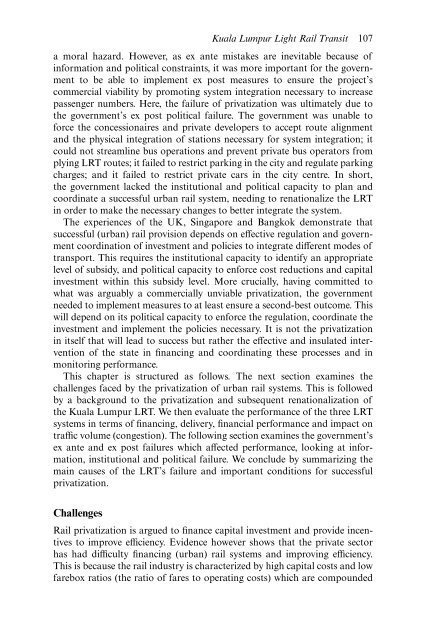PRIVATIZATION Privatization in Malaysia, Regulation, rent-seeking and policy failure
PRIVATIZATION Privatization in Malaysia, Regulation, rent-seeking and policy failure
PRIVATIZATION Privatization in Malaysia, Regulation, rent-seeking and policy failure
You also want an ePaper? Increase the reach of your titles
YUMPU automatically turns print PDFs into web optimized ePapers that Google loves.
Kuala Lumpur Light Rail Transit 107a moral hazard. However, as ex ante mistakes are <strong>in</strong>evitable because of<strong>in</strong>formation <strong>and</strong> political constra<strong>in</strong>ts, it was more important for the governmentto be able to implement ex post measures to ensure the project’scommercial viability by promot<strong>in</strong>g system <strong>in</strong>tegration necessary to <strong>in</strong>creasepassenger numbers. Here, the <strong>failure</strong> of privatization was ultimately due tothe government’s ex post political <strong>failure</strong>. The government was unable toforce the concessionaires <strong>and</strong> private developers to accept route alignment<strong>and</strong> the physical <strong>in</strong>tegration of stations necessary for system <strong>in</strong>tegration; itcould not streaml<strong>in</strong>e bus operations <strong>and</strong> prevent private bus operators fromply<strong>in</strong>g LRT routes; it failed to restrict park<strong>in</strong>g <strong>in</strong> the city <strong>and</strong> regulate park<strong>in</strong>gcharges; <strong>and</strong> it failed to restrict private cars <strong>in</strong> the city centre. In short,the government lacked the <strong>in</strong>stitutional <strong>and</strong> political capacity to plan <strong>and</strong>coord<strong>in</strong>ate a successful urban rail system, need<strong>in</strong>g to renationalize the LRT<strong>in</strong> order to make the necessary changes to better <strong>in</strong>tegrate the system.The experiences of the UK, S<strong>in</strong>gapore <strong>and</strong> Bangkok demonstrate thatsuccessful (urban) rail provision depends on effective regulation <strong>and</strong> governmentcoord<strong>in</strong>ation of <strong>in</strong>vestment <strong>and</strong> policies to <strong>in</strong>tegrate diffe<strong>rent</strong> modes oftransport. This requires the <strong>in</strong>stitutional capacity to identify an appropriatelevel of subsidy, <strong>and</strong> political capacity to enforce cost reductions <strong>and</strong> capital<strong>in</strong>vestment with<strong>in</strong> this subsidy level. More crucially, hav<strong>in</strong>g committed towhat was arguably a commercially unviable privatization, the governmentneeded to implement measures to at least ensure a second-best outcome. Thiswill depend on its political capacity to enforce the regulation, coord<strong>in</strong>ate the<strong>in</strong>vestment <strong>and</strong> implement the policies necessary. It is not the privatization<strong>in</strong> itself that will lead to success but rather the effective <strong>and</strong> <strong>in</strong>sulated <strong>in</strong>terventionof the state <strong>in</strong> f<strong>in</strong>anc<strong>in</strong>g <strong>and</strong> coord<strong>in</strong>at<strong>in</strong>g these processes <strong>and</strong> <strong>in</strong>monitor<strong>in</strong>g performance.This chapter is structured as follows. The next section exam<strong>in</strong>es thechallenges faced by the privatization of urban rail systems. This is followedby a background to the privatization <strong>and</strong> subsequent renationalization ofthe Kuala Lumpur LRT. We then evaluate the performance of the three LRTsystems <strong>in</strong> terms of f<strong>in</strong>anc<strong>in</strong>g, delivery, f<strong>in</strong>ancial performance <strong>and</strong> impact ontraffic volume (congestion). The follow<strong>in</strong>g section exam<strong>in</strong>es the government’sex ante <strong>and</strong> ex post <strong>failure</strong>s which affected performance, look<strong>in</strong>g at <strong>in</strong>formation,<strong>in</strong>stitutional <strong>and</strong> political <strong>failure</strong>. We conclude by summariz<strong>in</strong>g thema<strong>in</strong> causes of the LRT’s <strong>failure</strong> <strong>and</strong> important conditions for successfulprivatization.ChallengesRail privatization is argued to f<strong>in</strong>ance capital <strong>in</strong>vestment <strong>and</strong> provide <strong>in</strong>centivesto improve efficiency. Evidence however shows that the private sectorhas had difficulty f<strong>in</strong>anc<strong>in</strong>g (urban) rail systems <strong>and</strong> improv<strong>in</strong>g efficiency.This is because the rail <strong>in</strong>dustry is characterized by high capital costs <strong>and</strong> lowfarebox ratios (the ratio of fares to operat<strong>in</strong>g costs) which are compounded


